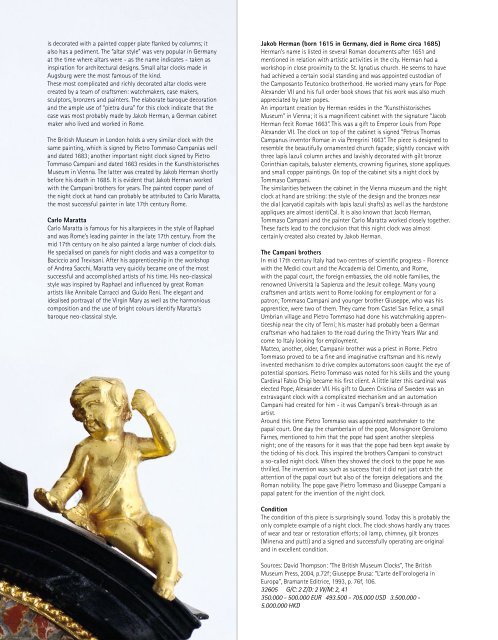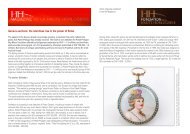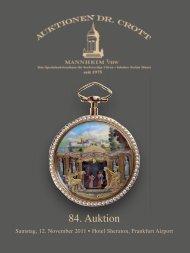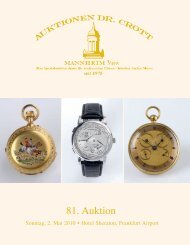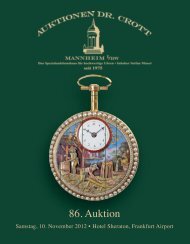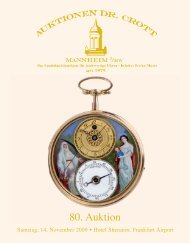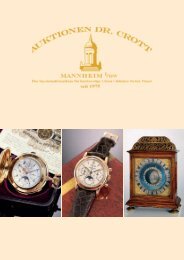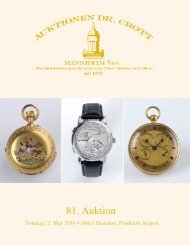83. Auktion - Auktionen Dr. Crott
83. Auktion - Auktionen Dr. Crott
83. Auktion - Auktionen Dr. Crott
Sie wollen auch ein ePaper? Erhöhen Sie die Reichweite Ihrer Titel.
YUMPU macht aus Druck-PDFs automatisch weboptimierte ePaper, die Google liebt.
is decorated with a painted copper plate flanked by columns; it<br />
also has a pediment. The “altar style” was very popular in Germany<br />
at the time where altars were - as the name indicates - taken as<br />
inspiration for architectural designs. Small altar clocks made in<br />
Augsburg were the most famous of the kind.<br />
These most complicated and richly decorated altar clocks were<br />
created by a team of craftsmen: watchmakers, case makers,<br />
sculptors, bronzers and painters. The elaborate baroque decoration<br />
and the ample use of “pietra dura” for this clock indicate that the<br />
case was most probably made by Jakob Herman, a German cabinet<br />
maker who lived and worked in Rome.<br />
The British Museum in London holds a very similar clock with the<br />
same painting, which is signed by Pietro Tommaso Campanias well<br />
and dated 1683; another important night clock signed by Pietro<br />
Tommaso Campani and dated 1663 resides in the Kunsthistorisches<br />
Museum in Vienna. The latter was created by Jakob Herman shortly<br />
before his death in 1685. It is evident that Jakob Herman worked<br />
with the Campani brothers for years. The painted copper panel of<br />
the night clock at hand can probably be attributed to Carlo Maratta,<br />
the most successful painter in late 17th century Rome.<br />
Carlo Maratta<br />
Carlo Maratta is famous for his altarpieces in the style of Raphael<br />
and was Rome’s leading painter in the late 17th century. From the<br />
mid 17th century on he also painted a large number of clock dials.<br />
He specialised on panels for night clocks and was a competitor to<br />
Baciccio and Trevisani. After his apprenticeship in the workshop<br />
of Andrea Sacchi, Maratta very quickly became one of the most<br />
successful and accomplished artists of his time. His neo-classical<br />
style was inspired by Raphael and influenced by great Roman<br />
artists like Annibale Carracci and Guido Reni. The elegant and<br />
idealised portrayal of the Virgin Mary as well as the harmonious<br />
composition and the use of bright colours identify Maratta’s<br />
baroque neo-classical style.<br />
Jakob Herman (born 1615 in Germany, died in Rome circa 1685)<br />
Herman’s name is listed in several Roman documents after 1651 and<br />
mentioned in relation with artistic activities in the city. Herman had a<br />
workshop in close proximity to the St. Ignatius church. He seems to have<br />
had achieved a certain social standing and was appointed custodian of<br />
the Camposanto Teutonico brotherhood. He worked many years for Pope<br />
Alexander VII and his full order book shows that his work was also much<br />
appreciated by later popes.<br />
An important creation by Herman resides in the “Kunsthistorisches<br />
Museum” in Vienna; it is a magnificent cabinet with the signature “Jacob<br />
Herman fecit Romae 1663”. This was a gift to Emperor Louis from Pope<br />
Alexander VII. The clock on top of the cabinet is signed “Petrus Thomas<br />
Campanus inventor Romae in via Peregrini 1663”. The piece is designed to<br />
resemble the beautifully ornamented church façade; slightly concave with<br />
three lapis lazuli column arches and lavishly decorated with gilt bronze<br />
Corinthian capitals, baluster elements, crowning figurines, stone appliques<br />
and small copper paintings. On top of the cabinet sits a night clock by<br />
Tommaso Campani.<br />
The similarities between the cabinet in the Vienna museum and the night<br />
clock at hand are striking: the style of the design and the bronzes near<br />
the dial (caryatid capitals with lapis lazuli shafts) as well as the hardstone<br />
appliques are almost identiCal. It is also known that Jacob Herman,<br />
Tommaso Campani and the painter Carlo Maratta worked closely together.<br />
These facts lead to the conclusion that this night clock was almost<br />
certainly created also created by Jakob Herman.<br />
The Campani brothers<br />
In mid 17th century Italy had two centres of scientific progress - Florence<br />
with the Medici court and the Accademia del Cimento, and Rome,<br />
with the papal court, the foreign embassies, the old noble families, the<br />
renowned Università la Sapienza and the Jesuit college. Many young<br />
craftsmen and artists went to Rome looking for employment or for a<br />
patron; Tommaso Campani and younger brother Giuseppe, who was his<br />
apprentice, were two of them. They came from Castel San Felice, a small<br />
Umbrian village and Pietro Tommaso had done his watchmaking apprenticeship<br />
near the city of Terni; his master had probably been a German<br />
craftsman who had.taken to the road during the Thirty Years War and<br />
come to Italy looking for employment.<br />
Matteo, another, older, Campanir brother was a priest in Rome. Pietro<br />
Tommaso proved to be a fine and imaginative craftsman and his newly<br />
invented mechanism to drive complex automatons soon caught the eye of<br />
potential sponsors. Pietro Tommaso was noted for his skills and the young<br />
Cardinal Fabio Chigi became his first client. A little later this cardinal was<br />
elected Pope, Alexander VII. His gift to Queen Cristina of Sweden was an<br />
extravagant clock with a complicated mechanism and an automation<br />
Campani had created for him - it was Campani’s break-through as an<br />
artist.<br />
Around this time Pietro Tommaso was appointed watchmaker to the<br />
papal court. One day the chamberlain of the pope, Monsignore Gerolomo<br />
Farnes, mentioned to him that the pope had spent another sleepless<br />
night; one of the reasons for it was that the pope had been kept awake by<br />
the ticking of his clock. This inspired the brothers Campani to construct<br />
a so-called night clock. When they showed the clock to the pope he was<br />
thrilled. The invention was such as success that it did not just catch the<br />
attention of the papal court but also of the foreign delegations and the<br />
Roman nobility. The pope gave Pietro Tommaso and Giuseppe Campani a<br />
papal patent for the invention of the night clock.<br />
Condition<br />
The condition of this piece is surprisingly sound. Today this is probably the<br />
only complete example of a night clock. The clock shows hardly any traces<br />
of wear and tear or restoration efforts; oil lamp, chimney, gilt bronzes<br />
(Minerva and putti) and a signed and successfully operating are original<br />
and in excellent condition.<br />
Sources: David Thompson: “The British Museum Clocks”, The British<br />
Museum Press, 2004, p.72f; Giuseppe Brusa: “L’arte dell’orologeria in<br />
Europa”, Bramante Editrice, 1993, p. 76f, 106.<br />
32605 G/C: 2 Z/D: 2 W/M: 2, 41<br />
350.000 - 500.000 EUR 493.500 - 705.000 USD 3.500.000 -<br />
5.000.000 HKD


